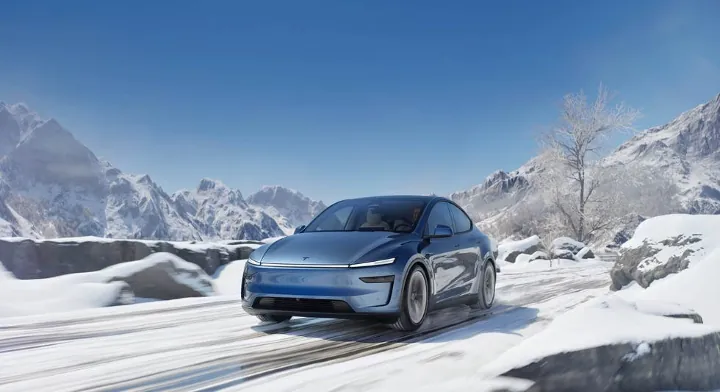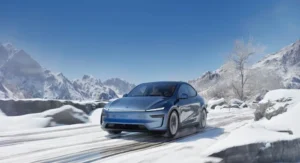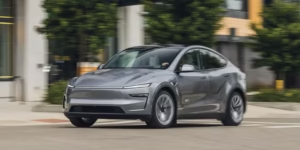
Alaska’s winters are a spectacle of nature’s raw power, towering snowdrifts, endless nights, and temperatures that plunge well below zero. For Tesla owners, this frozen frontier presents unique challenges to electric vehicle (EV) ownership. Driving a Tesla in winter in Alaska isn’t just about navigating icy roads; it’s about optimizing battery performance, ensuring safety, and embracing the adventure with smart preparation. If you’re searching for Tesla winter tips Alaska or ways to maintain your electric car winter driving efficiency in subzero conditions, this guide is your roadmap.
As an EV pioneer, Tesla’s lineup, from the nimble Model 3 to the rugged Cybertruck, excels in efficiency and technology. However, cold weather can reduce battery range by up to 40%, according to Tesla’s own data and real-world tests from owners in harsh climates. But fear not: with the right strategies, you can conquer Alaska’s winters without sacrificing the joy of silent, torque-rich acceleration. In this comprehensive post, we’ll cover preparation, battery management, safe driving techniques, charging hacks, and more, infused with real stories from Tesla owners who’ve braved the Last Frontier’s frosts. Whether you’re commuting from Anchorage to the Mat Su Valley or exploring the Kenai Peninsula, these tips for driving a Tesla in winter Alaska will keep you powered up and on track.
Preparing Your Tesla for Alaska’s Harsh Winters
Preparation is the cornerstone of successful Tesla winter driving in Alaska. Start by understanding your vehicle’s needs months in advance. Alaska’s Department of Transportation reports average winter temperatures dipping to -20°F (-29°C) in interior regions, with coastal areas like Juneau seeing frequent snow squalls. These conditions demand proactive vehicle setup.
First, invest in winter tires. Tesla recommends all-season tires for mild winters, but for Alaska, switch to dedicated winter tires with the three-peak mountain snowflake (3PMSF) symbol. Brands like Michelin X-Ice or Nokian Hakkapeliitta excel on packed snow and black ice. Ensure they’re mounted on lightweight alloy wheels to minimize rotational mass, preserving precious range. Professional installation at a Tesla Service Center in Anchorage or Fairbanks is ideal, as they can calibrate your tire pressure monitoring system (TPMS) for cold-weather accuracy, tires lose about 1 PSI per 10°F drop.
Real owners echo this: One Anchorage-based Tesla enthusiast shared on Reddit that their first winter with a Model Y was “an absolute pleasure,” crediting dedicated snow tires for making the vehicle handle ice “like a champ” without any slips during early-season storms. Next, enable Tesla’s Cabin Overheat Protection and preconditioning features via the app. Schedule your departure time in the Tesla app to warm the cabin and battery en route to work or a trailhead. This uses grid power (if plugged in) rather than battery juice, a game-changer for EV winter prep Alaska. For multi-day trips, like the Alaska Highway, pack an emergency kit: tow rope, shovel, thermal blankets, and a portable jump starter compatible with Tesla’s 12V system.
Don’t overlook software updates. Tesla’s over-the-air (OTA) updates often include winter-specific enhancements, such as improved regenerative braking on slippery surfaces. Check for updates weekly, especially before storms. Owners in Homer report that the latest Full Self-Driving (FSD) beta handles snow better with adaptive cruise control tweaks.
Finally, insulate your garage if possible. Even a basic door seal can raise ambient temps by 10°F, reducing initial preconditioning time. By fall, these steps transform your Tesla from a fair-weather friend into an Arctic ally.
Battery and Range Management: Keeping the Juice Flowing in Freezing Temps
Nothing tests a Tesla owner’s mettle like watching range plummet in the cold. Lithium-ion batteries in Models S, 3, X, Y, and Cybertruck hate the freeze, their chemical reactions slow, cutting efficiency. In Alaska’s winters, where Willow averages 90 inches of snow and -35°F days, expect 20-40% range loss. But with savvy management, you can mitigate this for seamless Tesla Alaska winter driving.
The hero here is battery preconditioning. Activate it 30-45 minutes before driving via the app’s navigation feature. For a Model Y heading to Denali National Park, route planning automatically preconditions to optimal temps (around 70°F/21°C), boosting regen braking and highway efficiency. Pro tip: Park in “Keep Climate On” mode during short stops to maintain battery warmth without draining it dry, set it to dog mode for pet safety on those long idles.
Layer on efficient heating. Cabin heat is a battery vampire, guzzling up to 10 kW in extreme cold. Instead, prioritize heated seats, steering wheel, and preconditioned wipers. Tesla’s heat pump (standard on newer models) is 3x more efficient than resistive heaters, but supplement with a cabin air filter swap to prevent snow-clogged intakes. Real-world data from Tesla forums shows this combo saves 15-20% range on a 200-mile Anchorage-to-Valdez run.
Monitor your energy app religiously. Use the Consumption graph to track vampire drain, those sneaky sentry mode and app checks add up in the cold. Disable non-essentials like Cabin Overheat if you’re not using it. For long hauls, like the Dalton Highway to Prudhoe Bay, factor in headwinds and elevation; Tesla’s Trip Planner accounts for weather, but manually add 30% buffer.
One longtime Alaskan owner, who’s logged three years with an FSD-equipped Model S, swears by these tactics on their benchmark four-hour round trip from Anchorage to Seward. “Efficiency held steady despite the chill,” they noted, though they advised buffering for unexpected FSD hesitations in fresh powder. Hydration for your EV? Keep the battery “hydrated” by avoiding full discharges. Charge to 80-90% daily, and use Level 2 home chargers for overnight top-ups. In Alaska’s short days, solar-assisted chargers are emerging in places like Soldotna, blending renewables with your grid-tied setup.
By treating your battery like a finicky sled dog, warm it up, feed it right, and don’t overwork it, you’ll extend range and lifespan, even in -40°F chills.
Safe Driving Techniques: Navigating Ice, Snow, and Slush with Confidence
Alaska’s roads transform into a slippery ballet in winter, The Parks Highway sees black ice fatalities yearly, per DOT stats. Tesla’s low center of gravity and instant torque make it a handling champ, but safe Tesla driving in Alaska winter requires blending tech with technique.
Regenerative braking is your best friend on snow, but calibrate it wisely. Set to “Low” in the settings for gradual stops, preventing fishtails. On packed snow, it feels like engine braking in a gas car, recapturing energy while maintaining control. Practice in empty lots near Wasilla, Eagle River or Anchorage; many owners swear by it for the Glenn Highway’s curves.
Autopilot and FSD shine here, but use them judiciously. Tesla’s vision-based system detects lane markings under light snow, but heavy flurries demand full manual mode. Enable Traffic-Aware Cruise Control for steady speeds on the Parks Highway, reducing fatigue during uo to 9-hour drives to Fairbanks in the winter. Remember, no system replaces vigilance, scan for moose shadows in headlights.
Traction control is non-negotiable. Tesla’s stability system cuts power to spinning wheels faster than you can blink, but pair it with cautious acceleration. In the Cybertruck’s case, its steer-by-wire and four-wheel steering excel on unplowed roads, offering a tighter turning radius than traditional trucks.
Visibility is key: Activate heated wipers and mirrors pre-departure. Tesla’s auto-headlights adjust for twilight, but add LED fog lights for pea-soup conditions in the Mat-Su Valley. Slow down, Alaska law mandates chains on certain passes like Atigun (but who goes there in the winter besides the Ice Road Truckers!), and Tesla owners have successfully used cable chains on Model 3 without voiding warranties.
These features saved one early adopter during their inaugural winter outing. Spotting a Tesla on a sheer, ice-slicked incline in Anchorage’s Hillside neighborhood, the driver recounted heart-pounding moments where regen braking and traction control turned potential disaster into a controlled descent: “I have a lot of experience in winter driving, but this slope had me worried, until the Tesla proved unflappable.” For epic journeys, consider the tale of two 83-year-old Alaskans, married 63 years, who in late 2025 planned a 5,000-mile Cybertruck trek from Giga Texas home via the icy Alcan Highway. Relying fully on FSD through -20°F temps and snow, they trusted Tesla’s engineering implicitly: “We’re validating autonomous driving like no one else, putting our lives in Elon’s hands.”
Emergency protocols: If stranded, use the app’s SOS for roadside assistance, Tesla’s network covers remote spots via partnerships with AAA. Share your location with Tesla Roadside, and keep a satellite communicator like Garmin inReach for no-signal zones.
Master these, and your Tesla becomes a safe haven amid the storm, turning perilous drives into poetic journeys.
Charging Strategies: Powering Up Amid the Frost
Charging in Alaska’s winter is a logistical puzzle, Superchargers are beginning to dot the Railbelt, but remote areas like the eastern part of the state (Tok) lag. For Tesla charging tips winter Alaska, prioritize accessibility and efficiency.
Home is base camp: Install a Wall Connector in your garage for 44 miles/hour gains. In cold snaps, plug in immediately upon arrival; preconditioning pulls from the wall, not the pack. For apartments in Juneau, public Level 2 stations at libraries or malls bridge gaps.
Superchargers are lifelines, V3 units in Fairbanks (coming online soon) deliver 250 kW, but precondition to hit peak speeds. Tesla’s navigation predicts stall wait times, crucial during holiday rushes. In extreme weather, opt for covered stations like those at Three Bears in Chugiak to make sure you make it home on a long commute.
Destination charging expands options: Hotels along the Glenn, Parks and Seward Highways, like the Millennium Hotel, offer free JuiceBox units. Plan via PlugShare app, filtering for cold-weather reliability.
For off-grid adventures, portable solutions like the Tesla Mobile Connector with a generator work, but noise and fuel defeat the EV ethos. Emerging tech, like bidirectional charging in future models, could power cabins from your battery.
Efficiency hack: Charge during off-peak hours for lower rates, Matanuska Electric’s tiers save 50%. Monitor via their off-peak program. A little further north, one Fairbanks owner noted that preconditioned Supercharging sessions kept their subzero efficiency above 2.5 mi/kWh, even on multi-stop runs.
One Redditor exclamined: “Drove my Model 3 around in Fairbanks and North Pole, AK today. Phone said it was -36° but my car never read colder than -33°. It was a 50 mile round trip and I used exactly 100 miles of rated range so a nice round 50% loss. I had the seat heater on and the climate set to 73° although it was having a hard time keeping up. Seat heater worked great though.
No real issues driving it that I noticed besides some slightly stiffer steering.
It might still drop into the the -40’s and 50’s later this winter so I’ll see if I can gather up the courage to go out and test it in those conditions as well.”
Essential Accessories and Maintenance for Peak Performance
Round out your kit with must-haves: All-weather floor liners trap slush, battery insulating blankets for parked EVs, and a snow broom with ice scraper. Schedule winter service checks though EVs need less, Tesla recommends annual inspections.
Software-wise, enable Winter Mode if available in updates; it optimizes HVAC for cold starts.
Embrace the Electric Arctic Adventure
Driving a Tesla in Alaska’s winter is more than survival, it’s thriving in innovation’s embrace, as proven by owners from Reddit threads to X timelines. From preconditioned batteries to regen-savvy braking, these tips for Tesla in Alaska winter equip you for majesty and mishaps alike. Range anxiety fades with planning, safety blooms from smarts. Ready to charge into the aurora-lit night? Update your app, tire up, and go, your Tesla awaits the call of the wild.
For more insights, subscribe to our newsletter. Safe travels, Alaskans!











